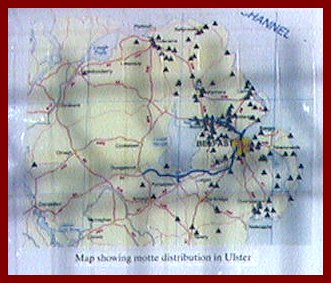
(www.nitowns.com)
Antrim Town, Co Antrim
Having entered Ulster
in 1171 under the leadership of John de Courcy, the Normans had settled
the area around the Six-Mile-Water by 1226, and the organised approach,
with carefully laid out farms and manors, formed the basis of the area as we
know today. Center to the organisation was the "motte", a mound of earth
which was to be fortified and topped with a simple tower or Castle, usually
a wooden structure which in many cases would be replaced by stone.
In the Six-Mile-Water river vally many of these motts still remain, with
no less than 13 within a radius of about six miles of Antrim Borough.
The ajoining map of moat distribution in Ulster also highlights the concertration
of motts in counties Antrim and Down and illastrates the relatively limited
success of the Norman colonisation of Ulster.

The most important motte,
however, is the one that stand here in the Antrim Castle grounds and which,
as de Courcy's main outpost in the area, known as "Antrum Castle" gave the town
and county its name.
Since it's construction the motte has served as both a Norman and plantation
stronghold, a base for a cannon named "Roarin Tatty" which saw service until
the 1798 rebellion and as a garden feature complete with a yew hedgeing spiral
path leading to the summit.

Artists impression of an Anglo-Norman Motte
Restoration
of the motte
In 1990 Antrim Borough
Councill initated a program of restoration in the grounds to restore many of
the orignal features. While some work had been done on the motte in 1994
to fence the spiral path and reduce soil erosion, by 1998 a full restoration
program was drawn up to repair the damage which had emanited from a number of
sources over the years. Rain fall wash had caused much erosion of the
eastern slope and this had been exacerbated by a huge evergreen tree growing
only a few meters from the base of the motte which had both blocked sunlight,
causing retardation of the growth of plants and grass and directed more
rain water in run-off onto the slope. Yew and pine trees dating back to
the motts use as a garden feature in Victorian times, had been allowed to grow
out of control, therby causing shading which reduced plant life beneath them
as well as creating increased compitition for limited water supply.
The drought stress caused by this, allied to the nature of th substrue, was
causing the soil to become open to the wind and water and human erosion which
in turn prevented re-vegetation through slicking and root sheer. Earlier
effords to consoildate the soil by covering large areas with plastic holed matting
had only partly been successful and in some areas had actually been counter-productive
in that it prevented new growth. On parts of the motte not affected by
the ravashes of erosion, grass was actually choking the young yew trees and
preventing there development.
The princapal aims of the restoration plan were the removable of dead trees,
and the securing of the site to allow natural vegeneration and prevent further
damage. A tree surgen was brought in to remove holly, elder and lawson
cypress trees, grind out old stumps and
fell dead pine and yew trees to ease the stress being placed on the soil and
open up the site. They also clipped and pruned yew trees to incorage the
recreation of the spiral hedge which was once a feature of the site. Chestnut
fencing was also removed and the path repaired, while mesh on the ground was
replaced with ivy whose roots would bind the soil more successfully and combat
wind erosion. Finally a boundry fence was erected to secure the site and
allow natural, but managed regeneration to take place without the pressures
inflicted on the site by open public access.
The recovery of the site is monotered on an outgoing basis, and it is anticipited
that the boundry fence will remain inplace until at least the year 2010.
As the site is scheduled under the
Historic Monuments and Archacological objects order (NI) 1995 and is monitered
by the environment and Heritage service, D.O.E N.I, this body has to be consulted
at eash stage of the restoration, and be in attendence to examine soil samples
for archacological remains as well as advising on the fencing used and its insulation
restoration through careful maintance is still outgoing, but access can be gained
by obtaining a key to the gate in the fence, a payment of £5.00 refundable deposit
at the nearby Clotworthy house arts center.
www.nitowns.com
© Copyright 1999-2010
All Rights Reserved